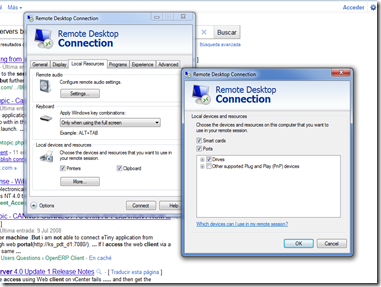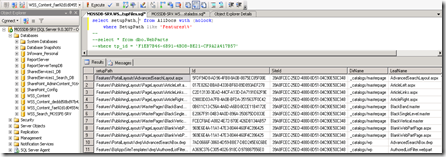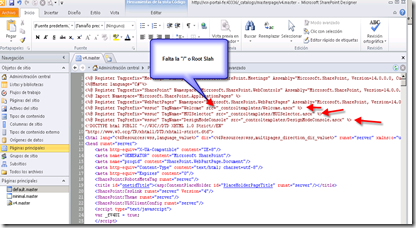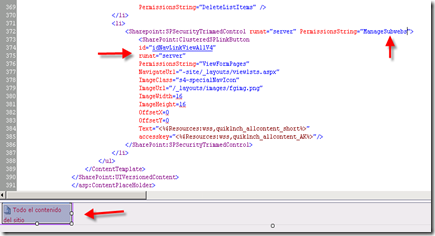Luego de realizar una migración a SP 2010 o bien crear una instalación totalmente nueva este mensaje aparece y otros mas relacionados con elementos Web del Search.
[MissingWebPart] WebPart class [baf5274e-a800-8dc3-96d0-0003d9405663] is referenced [23] times in the database [SharePoint_AdminContent_e622dc7a-cd8b-4a12-8ba9-916a2d8cf8cd], but is not installed on the current farm. Please install any feature/solution which contains this web part. One or more web parts are referenced in the database [SharePoint_AdminContent_e622dc7a-cd8b-4a12-8ba9-916a2d8cf8cd], but are not installed on the current farm. Please install any feature or solution which contains these web parts.
[MissingWebPart] WebPart class [9eba9c17-3b89-a2e7-a3cf-0ee3d7c2adb1] (class [Microsoft.Office.Server.Search.WebControls.SearchTopologyView] from assembly [Microsoft.Office.Server.Search, Version=14.0.0.0, Culture=neutral, PublicKeyToken=71e9bce111e9429c]) is referenced [1] times in the database [SharePoint_AdminContent_e622dc7a-cd8b-4a12-8ba9-916a2d8cf8cd], but is not installed on the current farm. Please install any feature/solution which contains this web part. One or more web parts are referenced in the database [SharePoint_AdminContent_e622dc7a-cd8b-4a12-8ba9-916a2d8cf8cd], but are not installed on the current farm. Please install any feature or solution which contains these web parts.
[MissingWebPart] WebPart class [07f48b68-2e69-c86a-ebe4-16359e03ebc2] (class [Microsoft.Office.Server.Search.WebControls.AdvancedSearchBox] from assembly [Microsoft.Office.Server.Search, Version=14.0.0.0, Culture=neutral, PublicKeyToken=71e9bce111e9429c]) is referenced [1] times in the database [SharePoint_AdminContent_e622dc7a-cd8b-4a12-8ba9-916a2d8cf8cd], but is not installed on the current farm. Please install any feature/solution which contains this web part. One or more web parts are referenced in the database [SharePoint_AdminContent_e622dc7a-cd8b-4a12-8ba9-916a2d8cf8cd], but are not installed on the current farm. Please install any feature or solution which contains these web parts.
[MissingWebPart] WebPart class [23091f6c-295d-4493-504c-1714a20d65a2] (class [Microsoft.Office.Server.Search.WebControls.PeopleRefinementWebPart] from assembly [Microsoft.Office.Server.Search, Version=14.0.0.0, Culture=neutral, PublicKeyToken=71e9bce111e9429c]) is referenced [1] times in the database [SharePoint_AdminContent_e622dc7a-cd8b-4a12-8ba9-916a2d8cf8cd], but is not installed on the current farm. Please install any feature/solution which contains this web part. One or more web parts are referenced in the database [SharePoint_AdminContent_e622dc7a-cd8b-4a12-8ba9-916a2d8cf8cd], but are not installed on the current farm. Please install any feature or solution which contains these web parts.
[MissingWebPart] WebPart class [7d319bdd-d90e-7861-b7f0-2f9f4cec3004] (class [Microsoft.Office.Server.Search.WebControls.CoreResultsWebPart] from assembly [Microsoft.Office.Server.Search, Version=14.0.0.0, Culture=neutral, PublicKeyToken=71e9bce111e9429c]) is referenced [2] times in the database [SharePoint_AdminContent_e622dc7a-cd8b-4a12-8ba9-916a2d8cf8cd], but is not installed on the current farm. Please install any feature/solution which contains this web part. One or more web parts are referenced in the database [SharePoint_AdminContent_e622dc7a-cd8b-4a12-8ba9-916a2d8cf8cd], but are not installed on the current farm. Please install any feature or solution which contains these web parts.
[MissingWebPart] WebPart class [c744e2b2-158c-c2f8-2f80-54bf046ff644] (class [Microsoft.SharePoint.Portal.WebControls.PeopleSearchBoxEx] from assembly [Microsoft.SharePoint.Portal, Version=14.0.0.0, Culture=neutral, PublicKeyToken=71e9bce111e9429c]) is referenced [1] times in the database [SharePoint_AdminContent_e622dc7a-cd8b-4a12-8ba9-916a2d8cf8cd], but is not installed on the current farm. Please install any feature/solution which contains this web part. One or more web parts are referenced in the database [SharePoint_AdminContent_e622dc7a-cd8b-4a12-8ba9-916a2d8cf8cd], but are not installed on the current farm. Please install any feature or solution which contains these web parts.
[MissingWebPart] WebPart class [b36f9dfe-325a-1b44-e6bb-645dcf79c770] (class [Microsoft.Office.Server.Search.WebControls.FarmSystemStatus] from assembly [Microsoft.Office.Server.Search, Version=14.0.0.0, Culture=neutral, PublicKeyToken=71e9bce111e9429c]) is referenced [1] times in the database [SharePoint_AdminContent_e622dc7a-cd8b-4a12-8ba9-916a2d8cf8cd], but is not installed on the current farm. Please install any feature/solution which contains this web part. One or more web parts are referenced in the database [SharePoint_AdminContent_e622dc7a-cd8b-4a12-8ba9-916a2d8cf8cd], but are not installed on the current farm. Please install any feature or solution which contains these web parts.
[MissingWebPart] WebPart class [0a60f514-1dea-8537-b588-64ee5e224da3] (class [Microsoft.SharePoint.Portal.WebControls.SearchBoxEx] from assembly [Microsoft.Office.Server.Search, Version=14.0.0.0, Culture=neutral, PublicKeyToken=71e9bce111e9429c]) is referenced [2] times in the database [SharePoint_AdminContent_e622dc7a-cd8b-4a12-8ba9-916a2d8cf8cd], but is not installed on the current farm. Please install any feature/solution which contains this web part. One or more web parts are referenced in the database [SharePoint_AdminContent_e622dc7a-cd8b-4a12-8ba9-916a2d8cf8cd], but are not installed on the current farm. Please install any feature or solution which contains these web parts.
[MissingWebPart] WebPart class [9f56656f-6aa3-0d55-a812-711bf65864ea] is referenced [119] times in the database [SharePoint_AdminContent_e622dc7a-cd8b-4a12-8ba9-916a2d8cf8cd], but is not installed on the current farm. Please install any feature/solution which contains this web part. One or more web parts are referenced in the database [SharePoint_AdminContent_e622dc7a-cd8b-4a12-8ba9-916a2d8cf8cd], but are not installed on the current farm. Please install any feature or solution which contains these web parts.
[MissingWebPart] WebPart class [9637ed85-7d44-e135-35ba-73ce390ebf93] (class [Microsoft.Office.Server.Search.WebControls.SearchPagingWebPart] from assembly [Microsoft.Office.Server.Search, Version=14.0.0.0, Culture=neutral, PublicKeyToken=71e9bce111e9429c]) is referenced [2] times in the database [SharePoint_AdminContent_e622dc7a-cd8b-4a12-8ba9-916a2d8cf8cd], but is not installed on the current farm. Please install any feature/solution which contains this web part. One or more web parts are referenced in the database [SharePoint_AdminContent_e622dc7a-cd8b-4a12-8ba9-916a2d8cf8cd], but are not installed on the current farm. Please install any feature or solution which contains these web parts.
[MissingWebPart] WebPart class [2fc2e287-55c9-b5d1-0d5c-7458bc3c9841] (class [Microsoft.SharePoint.Portal.WebControls.ContactFieldControl] from assembly [Microsoft.SharePoint.Portal, Version=14.0.0.0, Culture=neutral, PublicKeyToken=71e9bce111e9429c]) is referenced [1] times in the database [SharePoint_AdminContent_e622dc7a-cd8b-4a12-8ba9-916a2d8cf8cd], but is not installed on the current farm. Please install any feature/solution which contains this web part. One or more web parts are referenced in the database [SharePoint_AdminContent_e622dc7a-cd8b-4a12-8ba9-916a2d8cf8cd], but are not installed on the current farm. Please install any feature or solution which contains these web parts.
[MissingWebPart] WebPart class [8acac35f-e9d3-95c3-76c7-76fe034cef50] (class [Microsoft.Office.Server.Search.WebControls.SearchSummaryWebPart] from assembly [Microsoft.Office.Server.Search, Version=14.0.0.0, Culture=neutral, PublicKeyToken=71e9bce111e9429c]) is referenced [1] times in the database [SharePoint_AdminContent_e622dc7a-cd8b-4a12-8ba9-916a2d8cf8cd], but is not installed on the current farm. Please install any feature/solution which contains this web part. One or more web parts are referenced in the database [SharePoint_AdminContent_e622dc7a-cd8b-4a12-8ba9-916a2d8cf8cd], but are not installed on the current farm. Please install any feature or solution which contains these web parts.
[MissingWebPart] WebPart class [926a1a3e-d1ff-f58f-8b3a-854974660703] (class [Microsoft.Office.Server.Search.WebControls.ContentSourcesStatus] from assembly [Microsoft.Office.Server.Search, Version=14.0.0.0, Culture=neutral, PublicKeyToken=71e9bce111e9429c]) is referenced [1] times in the database [SharePoint_AdminContent_e622dc7a-cd8b-4a12-8ba9-916a2d8cf8cd], but is not installed on the current farm. Please install any feature/solution which contains this web part. One or more web parts are referenced in the database [SharePoint_AdminContent_e622dc7a-cd8b-4a12-8ba9-916a2d8cf8cd], but are not installed on the current farm. Please install any feature or solution which contains these web parts.
[MissingWebPart] WebPart class [f9c020f4-bcb2-3629-0460-9e5ec4c9de93] (class [Microsoft.Office.Server.Search.WebControls.QuerySuggestionsWebPart] from assembly [Microsoft.Office.Server.Search, Version=14.0.0.0, Culture=neutral, PublicKeyToken=71e9bce111e9429c]) is referenced [1] times in the database [SharePoint_AdminContent_e622dc7a-cd8b-4a12-8ba9-916a2d8cf8cd], but is not installed on the current farm. Please install any feature/solution which contains this web part. One or more web parts are referenced in the database [SharePoint_AdminContent_e622dc7a-cd8b-4a12-8ba9-916a2d8cf8cd], but are not installed on the current farm. Please install any feature or solution which contains these web parts.
[MissingWebPart] WebPart class [de8c8afc-7c6e-e9fc-91c2-aa4a291c3623] (class [Microsoft.Office.Server.Search.WebControls.SearchApplicationSystemStatus] from assembly [Microsoft.Office.Server.Search, Version=14.0.0.0, Culture=neutral, PublicKeyToken=71e9bce111e9429c]) is referenced [1] times in the database [SharePoint_AdminContent_e622dc7a-cd8b-4a12-8ba9-916a2d8cf8cd], but is not installed on the current farm. Please install any feature/solution which contains this web part. One or more web parts are referenced in the database [SharePoint_AdminContent_e622dc7a-cd8b-4a12-8ba9-916a2d8cf8cd], but are not installed on the current farm. Please install any feature or solution which contains these web parts.
[MissingWebPart] WebPart class [bc8768f7-7d8c-1d56-b5a5-bb19cca9c7b8] (class [Microsoft.Office.Server.Search.WebControls.FederatedResultsWebPart] from assembly [Microsoft.Office.Server.Search, Version=14.0.0.0, Culture=neutral, PublicKeyToken=71e9bce111e9429c]) is referenced [1] times in the database [SharePoint_AdminContent_e622dc7a-cd8b-4a12-8ba9-916a2d8cf8cd], but is not installed on the current farm. Please install any feature/solution which contains this web part. One or more web parts are referenced in the database [SharePoint_AdminContent_e622dc7a-cd8b-4a12-8ba9-916a2d8cf8cd], but are not installed on the current farm. Please install any feature or solution which contains these web parts.
[MissingWebPart] WebPart class [83d7efb5-5a0a-0d4e-fc32-cf0eae4b6cb1] (class [Microsoft.Office.Server.Search.WebControls.SearchStatsWebPart] from assembly [Microsoft.Office.Server.Search, Version=14.0.0.0, Culture=neutral, PublicKeyToken=71e9bce111e9429c]) is referenced [2] times in the database [SharePoint_AdminContent_e622dc7a-cd8b-4a12-8ba9-916a2d8cf8cd], but is not installed on the current farm. Please install any feature/solution which contains this web part. One or more web parts are referenced in the database [SharePoint_AdminContent_e622dc7a-cd8b-4a12-8ba9-916a2d8cf8cd], but are not installed on the current farm. Please install any feature or solution which contains these web parts.
[MissingWebPart] WebPart class [42b6d12b-947f-6ec4-9540-dc2f3e8f2425] (class [Microsoft.Office.Server.Search.WebControls.PeopleCoreResultsWebPart] from assembly [Microsoft.Office.Server.Search, Version=14.0.0.0, Culture=neutral, PublicKeyToken=71e9bce111e9429c]) is referenced [2] times in the database [SharePoint_AdminContent_e622dc7a-cd8b-4a12-8ba9-916a2d8cf8cd], but is not installed on the current farm. Please install any feature/solution which contains this web part. One or more web parts are referenced in the database [SharePoint_AdminContent_e622dc7a-cd8b-4a12-8ba9-916a2d8cf8cd], but are not installed on the current farm. Please install any feature or solution which contains these web parts.
[MissingWebPart] WebPart class [3517e131-b02d-114b-1df2-dd9fa67b90c6] (class [Microsoft.Office.Server.Search.WebControls.TopFederatedResultsWebPart] from assembly [Microsoft.Office.Server.Search, Version=14.0.0.0, Culture=neutral, PublicKeyToken=71e9bce111e9429c]) is referenced [1] times in the database [SharePoint_AdminContent_e622dc7a-cd8b-4a12-8ba9-916a2d8cf8cd], but is not installed on the current farm. Please install any feature/solution which contains this web part. One or more web parts are referenced in the database [SharePoint_AdminContent_e622dc7a-cd8b-4a12-8ba9-916a2d8cf8cd], but are not installed on the current farm. Please install any feature or solution which contains these web parts.
[MissingWebPart] WebPart class [d46a22f8-7373-12cb-4e07-e1b78e3dba96] (class [Microsoft.Office.Server.Search.WebControls.RefinementWebPart] from assembly [Microsoft.Office.Server.Search, Version=14.0.0.0, Culture=neutral, PublicKeyToken=71e9bce111e9429c]) is referenced [1] times in the database [SharePoint_AdminContent_e622dc7a-cd8b-4a12-8ba9-916a2d8cf8cd], but is not installed on the current farm. Please install any feature/solution which contains this web part. One or more web parts are referenced in the database [SharePoint_AdminContent_e622dc7a-cd8b-4a12-8ba9-916a2d8cf8cd], but are not installed on the current farm. Please install any feature or solution which contains these web parts.
[MissingWebPart] WebPart class [5cc5df3a-29a8-a713-5898-e52e2dce72a8] (class [Microsoft.Office.Server.Search.WebControls.SearchApplicationShortcutsList] from assembly [Microsoft.Office.Server.Search, Version=14.0.0.0, Culture=neutral, PublicKeyToken=71e9bce111e9429c]) is referenced [1] times in the database [SharePoint_AdminContent_e622dc7a-cd8b-4a12-8ba9-916a2d8cf8cd], but is not installed on the current farm. Please install any feature/solution which contains this web part. One or more web parts are referenced in the database [SharePoint_AdminContent_e622dc7a-cd8b-4a12-8ba9-916a2d8cf8cd], but are not installed on the current farm. Please install any feature or solution which contains these web parts.
[MissingWebPart] WebPart class [874f5460-71f9-fecc-e894-e7e858d9713e] is referenced [71] times in the database [SharePoint_AdminContent_e622dc7a-cd8b-4a12-8ba9-916a2d8cf8cd], but is not installed on the current farm. Please install any feature/solution which contains this web part. One or more web parts are referenced in the database [SharePoint_AdminContent_e622dc7a-cd8b-4a12-8ba9-916a2d8cf8cd], but are not installed on the current farm. Please install any feature or solution which contains these web parts.
[MissingWebPart] WebPart class [ff79cbb5-48cf-96ee-3f74-f22cc1b00fbd] (class [Microsoft.Office.Server.Search.WebControls.FarmSearchApplicationList] from assembly [Microsoft.Office.Server.Search, Version=14.0.0.0, Culture=neutral, PublicKeyToken=71e9bce111e9429c]) is referenced [1] times in the database [SharePoint_AdminContent_e622dc7a-cd8b-4a12-8ba9-916a2d8cf8cd], but is not installed on the current farm. Please install any feature/solution which contains this web part. One or more web parts are referenced in the database [SharePoint_AdminContent_e622dc7a-cd8b-4a12-8ba9-916a2d8cf8cd], but are not installed on the current farm. Please install any feature or solution which contains these web parts.
[MissingWebPart] WebPart class [0ff9a0d5-1514-7a3b-fb97-fccbc902e380] (class [Microsoft.Office.Server.Search.WebControls.HighConfidenceWebPart] from assembly [Microsoft.Office.Server.Search, Version=14.0.0.0, Culture=neutral, PublicKeyToken=71e9bce111e9429c]) is referenced [1] times in the database [SharePoint_AdminContent_e622dc7a-cd8b-4a12-8ba9-916a2d8cf8cd], but is not installed on the current farm. Please install any feature/solution which contains this web part. One or more web parts are referenced in the database [SharePoint_AdminContent_e622dc7a-cd8b-4a12-8ba9-916a2d8cf8cd], but are not installed on the current farm. Please install any feature or solution which contains these web parts.




















